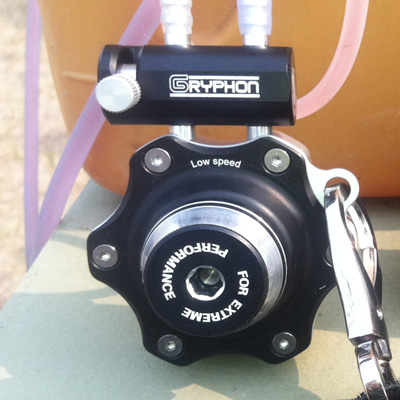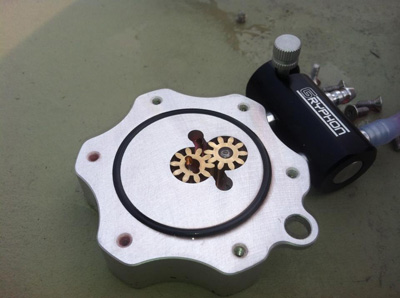Gryphon Fuel Pump
Written by Dan Reed
For those of you that have an affinity for nitro, it’s not uncommon to one day take a close look at your various parts containers and find a few fuel pumps, some work and some – lets be honest here – never did work. Just like you, I heard about the latest pump and I just had to give it a try. As we look over our collection of pumps that are now covered in a thick layer of dust that seems to cling to anything that comes in contact with nitro, we can remember taking it out of its packaging and thinking FINALLY!!! I have bought my last fuel pump. It’s ok, your in a safe place because we have all been there. I have five or six mechanical pumps, a few different brands of electric pumps ranging from the very inexpensive Mark V and the not so inexpensive Slimeline. We just want a pump that works consistently day in and day out…
I fly nitro mainly, and typically, during the summer months, I can use up to a case of fuel a week. That is a LOT of pumping! As I mentioned above, I had stopped using electric pumps, as they seemed to fail quickly and I had just resigned myself to manually pumping my beloved CoolPower 30%. I am not complaining because really its not that taxing to pump a few ounces of fuel. If you are anything like me, you can appreciate a tool that is designed well and just makes your hobby all that more enjoyable. I had my eye on a mechanical fuel pump that is manufactured by Gryphon for quite some time and every now and again you just have to treat yourself, so I pulled the trigger and a few days later it was at my doorstep.

The first thing I noticed about this pump is the substantial weight…it fits in the palm of your hand and it has a solid feel. I think, if you were so inclined, that you could use this pump as weapon to lay a beating on that guy at your field…you know who I’m talking about…every field has one :).
Basically, this pump consists of five parts: the cone/hex adapter, the shaft that drives the gears that create the flow, the front plate, the thick back-plate, and mixing switch.
Cone/hex adapter: For us heli guys it’s probably obvious what that hex shape at the very center of the pump is for – Yup, you simply insert your starter wand and hit the button and you have fuel running from your fuel jug to your heli. Now, for those of you that have some experience with RC airplanes, you might have already noticed that the top of the pump has a conical shape…you guessed it! For you plane fliers out there, you can use your starter even if you don’t have a starting wand. Nice touch, Gryphon!!!
You might notice the words typed on the front plate that say “low speed.” This pump comes in two versions: low speed and high speed. Low speed increases the flow rate of the pump itself to accommodate geared starters that have a lower RPM like an Align starter. Essentially, it creates a higher flow rate to regulate the the flow of fuel. Conversely, there is a high speed version that decreases the flow rate to accommodate non-geared starters such as Dynatron or Sullivan starters that have a higher RPM. Again, it regulates the flow of fuel to a slower rate. Why do we need to regulate the flow you ask? The idea is to not put undue pressure on your fuel fittings during the fueling process. Also if you happen to be using a fuel magnet, you want to be careful with the pressure you put on your lines so as not to distress the material and reduce its usable lifespan.
The cone/hex adapter attaches to the pump shaft via a grub screw. The pump shaft is approximately 4mm and tapers down to approximately 3mm. As it passes through the front plate it is sealed via a series of rubber grommets that keep the fuel from leaking out while pumping. At the distal end of the shaft is a hole drilled laterally that a short 5mm key fits in.

In the picture here, you can see the two brass gears that are the heart of the pump. The drive shaft fits into the lower gear and the lateral key fits in the slots you can see in that gear. From looking at this picture, you can see this is one SOLID unit. There essentially is nothing to wear out except for the gears…and you can imagine those gears stay well lubricated from pumping nitro.
Before I move, on let me relate one story that you might consider as a tip. If you are like me, you get curious about how things work and that means eventually most things you own end up in pieces on your bench. After I took this picture, I reassembled the pump and to my dismay, it was leaking horribly. I took it apart again and I just did not understand why this pump continued to leak. After a day or two of putting up with it, I was determined to figure it out. I took it apart again and, upon close inspection, I found there was one small blade of grass that was jammed into the rubber grommets that act as a seal causing the pump to leak and just not perform well. Moral of the story? Don’t take it apart!
Front Plate: The front plate is mostly cosmetic and it does look nice. The Gryphon pump comes in three distinct colors: red, blue, and black.
Back-plate: The back-plate is just one piece of aluminum and all the plumbing is CNC’d into the unit. I did not get a final weight of the Gryphon pump, but as I mentioned before, it’s solid.
Mixing Switch: On top of the Gryphon pump you have a directional switch that allows you to reverse the direction of the flow of fuel. There are two fuel tubing nipples on the top also. Without the switch, you would have to constantly change the fuel tubing around to send fuel to your model or retrieve fuel from your model after you’re done flying. The switch has a very tight tolerance and you can feel zero slop in its movements to the point that, the first few times you switch the direction of fuel, it will feel overly tight. Do not worry though…it does start to decrease in tension.
Let’s pump some fuel!!!
As of November of 2012, I have pumped eight cases of fuel through this pump. Aside from curiosity killing the cat as I explained above, this pump has been performing exceptionally since the day I started using it. Ergonomically, it fits perfectly in the palm of your hand and the ridges around the outer edge allow for a firm grip. I do need to tell you though, you do not need to keep a firm grip on the Gryphon pump while your using it…you can literally hold it with your pinky and your thumb while pumping fuel, as there is no torque at all while using it.
Just like anything we use that comes in contact with nitro, you will need to wipe it down on occasion. This will simply keep the dust from accumulating and turning into that nasty oily dirt. Not a big deal though, right? I mean you are wiping down you precious heli after you get done flying for the day…aren’t you?
Another consideration is the charging frequency for your starter battery is going to increase. I have been using my Align starter now for two full seasons. The first season, I charged it two or three times all season. I have noticed that now that I am charging the starter battery about every three weeks. Again, not a big deal, but I think it’s worth mentioning.
After using this pump for quite some time, I am happy to say that I do not regret buying it. At fun flies, it gets a fair amount of attention from heli and plane fliers alike. Here is the bottom line: do you need this pump? No. Can you get by without it? Absolutely. It is a bit spendy at about $115, but cost is relative. If this ends up being the last fuel pump you ever buy though, to me that makes the cost sound more reasonable. If you are like me and just like having tools that work, you will enjoy the Gryphon pump…there is no question.
– Dan
